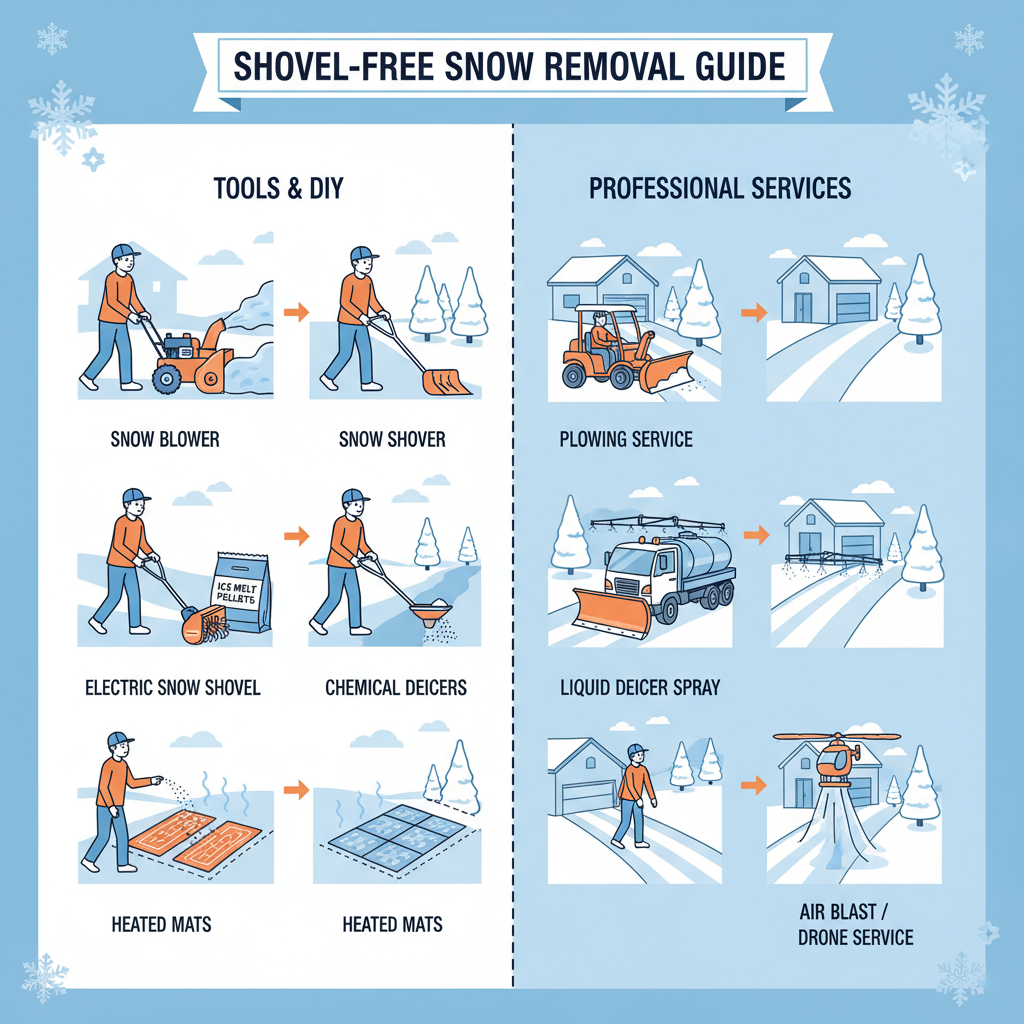TL;DR
- Snow plows are ideal for large, open areas like driveways and parking lots.
- Snow blowers are effective for moderate to heavy snow on various surfaces.
- Salt spreaders are crucial for applying de-icing agents to prevent ice formation.
- Shovels remain essential for detailed work and areas inaccessible to machinery.
- Specialized equipment like skid steers and roof rakes handle specific challenges.
- Choosing the right equipment depends on snow volume, property size, and desired efficiency.
When winter blankets your property in snow, a variety of tools and machines come into play to clear it away. From the basic shovel to powerful snow blowers and heavy-duty plows, each piece of equipment serves a specific purpose in the battle against winter’s white blanket.
Understanding the different types of snow removal equipment can help property owners appreciate the work involved and make informed decisions when hiring professional services.
1. Snow Plows
Snow plows are perhaps the most iconic symbol of professional snow removal.
- Description: A large blade, typically made of steel or polyethylene, attached to the front of a truck, SUV, ATV, or tractor.
- How it Works: The blade pushes snow to the side, clearing a path. Different blade angles and shapes (straight, V-plow, scoop) are designed for various snow conditions and pushing capacities.
- Best For: Large driveways, parking lots, private roads, and commercial properties. They are highly efficient for clearing wide, open areas quickly.
- Variations:
- Truck Plows: Most common for commercial and large residential jobs.
- ATV/UTV Plows: Suitable for smaller driveways, long pathways, or properties with tighter spaces.
- Tractor/Skid Steer Plows: Used for very large areas or heavy snow, offering significant pushing power.
2. Snow Blowers
Snow blowers are a popular choice for both homeowners and professionals, offering a step up from manual shoveling.
- Description: A machine that uses a rotating auger to collect snow and then a powerful impeller (fan) to discharge it through a chute.
- How it Works:
- Single-Stage: The auger directly throws the snow out the chute. Best for light to moderate snow (up to 8-10 inches) on paved surfaces.
- Two-Stage: An auger collects snow and feeds it to a high-speed impeller, which then throws it. Ideal for heavy, wet snow and deeper accumulations (over 10 inches) on various surfaces, including gravel.
- Three-Stage: Adds an accelerator to the two-stage system for even faster and more powerful snow removal, especially in very deep or icy conditions.
- Best For: Driveways, sidewalks, patios, and pathways. They reduce physical strain compared to shoveling.
3. Salt Spreaders / Sanders
These are essential for de-icing and improving traction.
- Description: Devices designed to evenly distribute granular materials like rock salt, calcium chloride, sand, or a mix of these.
- How it Works: They can be walk-behind models for small areas, tailgate-mounted for trucks, or V-box spreaders for larger commercial vehicles. They use a spinner or auger system to broadcast the material.
- Best For: Preventing ice formation (anti-icing) or melting existing ice (de-icing) on driveways, walkways, parking lots, and steps. Sand provides traction on slippery surfaces.
4. Shovels
The most basic, yet indispensable, tool for snow removal.
- Description: Manual tools with a blade and a handle, designed for pushing or lifting snow.
- How it Works: Requires manual effort to clear snow.
- Best For: Small areas, intricate pathways, steps, decks, and clearing around obstacles that machinery can’t reach. Essential for finishing touches after plowing or blowing.
- Variations:
- Push Shovels: Wide, curved blades for pushing snow.
- Scoop Shovels: Deeper blades for lifting and throwing snow.
- Ergonomic Shovels: Designed with curved handles to reduce back strain.
5. Specialized Equipment
For unique or challenging snow removal tasks, specialized equipment comes into play.
- Skid Steers and Loaders: Compact, powerful machines that can be fitted with various attachments (buckets, snow pushers, brooms) for heavy-duty snow removal on large commercial sites.
- Roof Rakes: Long-handled tools with a small blade, used to pull snow off roofs from the ground, preventing ice dams and structural stress.
- Heated Mats/Cables: While not “equipment” in the traditional sense, these systems are installed under surfaces to melt snow and ice automatically, offering a hands-free solution for specific areas.
Conclusion
From the simple shovel to advanced plows and blowers, each piece of snow removal equipment plays a vital role in keeping properties safe and accessible during winter. Understanding their functions and best uses can help property owners appreciate the effort involved in professional snow removal and make informed decisions about their own winter maintenance strategies.


